Explore the majestic beauty and rich heritage of royal Indian queen paintings through our curated collection. Each piece is a testament to the splendor of India’s regal past, featuring beautiful artworks by celebrated artists. Discover the stories behind these iconic works of art that have captivated the admiration of art enthusiasts worldwide. Join us on a visual journey of elegance and history.
Table of Contents
Introduction
The artistic representation of royalty in Indian paintings provides a vivid window into the country’s opulent past, showcasing the rich tapestry of its cultural heritage. Among these, the portraits of queens hold a special place, blending the realms of power and beauty with intricate artistic expressions. These paintings not only capture the regal poise and elegance of Indian queens but also embody the diverse artistic styles influenced by various dynasties and regions across centuries.
In this article, we will explore ten of the most beautiful Indian queen paintings created by some of the most famous artists in history. Each piece is a celebration of color, form, and history, offering insights into the lives of the women who played pivotal roles in shaping their kingdoms. From the detailed brushstrokes of the Mughal court to the vibrant colors of Rajput painting, these artworks are a testament to the skill and creativity of their creators.
By delving into each painting, we will uncover the stories behind these illustrious figures and the artistic movements they inspired. This journey through India’s royal art not only highlights the aesthetic achievements but also underscores the profound cultural narratives that these paintings preserve. Join us as we pay homage to the beauty and historical significance of these majestic works of art.
The Artistic Heritage of Indian Queen Paintings
The tradition of depicting royalty in Indian art spans several millennia, deeply rooted in the country’s rich dynastic histories and diverse cultural landscapes. Royal portraits, particularly those of queens, are more than just art; they are historical documents that offer a glimpse into the opulent courts and personal lives of India’s monarchy. These paintings evolved through various artistic styles, each influenced by the ruling dynasty of the time and the region’s cultural ethos.
Historical Context and Evolution
The earliest examples of Indian royal portraiture can be traced back to the ancient frescoes of Ajanta, which depict not only the Buddha and various Jataka tales but also royal figures in the courts and assemblies. As Indian art evolved, so did the portrayal of its queens. The Mughal era, beginning in the 16th century, marked a significant transformation in the art of portraiture. Mughal emperors commissioned artists to create detailed and lifelike portraits of their courts, including the queens and princesses, which served both as personal mementos and as instruments of political propaganda.
Following the Mughals, the Rajput kingdoms of the northwest embraced and adapted the Mughal portrait style, infusing it with their distinct aesthetic that emphasized vibrant colors and elaborate backgrounds. These paintings often highlighted the regal stature and divine right of the queens, depicting them in luxurious garments and elaborate jewelry, set against the backdrop of the lush landscapes of Rajasthan.
Regional Influences on Queen Portraiture
The depiction of queens in Indian art significantly varied from one region to another, influenced by local customs, religious practices, and artistic conventions. In South India, for example, the art of the Tanjore and Mysore schools brought forward a divine aspect of the queens by aligning them with goddesses from Hindu mythology, thus not only glorifying their beauty but also their spiritual significance.
In the eastern parts of India, particularly in Bengal, the influence of British colonialism introduced new techniques and realism in royal portraiture. The Company style of painting, which emerged during this period, reflected a synthesis of East and West, where Indian themes and subjects were depicted using European techniques and perspectives, offering a distinct portrayal of Indian queens that was both exotic and familiar to the colonial eye.
Through these varied depictions, Indian queen paintings have traveled a long artistic journey, narrating stories of power, grace, and cultural intermingling. Each artwork not only showcases the unique beauty of the queens but also reflects the rich tapestry of influences that shaped the regions from which they emerged. As we move forward, exploring each individual painting, we delve deeper into the essence of what these artistic treasures represent, celebrating their enduring legacy in the annals of art history.
Featured Paintings and Artists
1. “Queen Tissarakshita” by Abanindranath Tagore
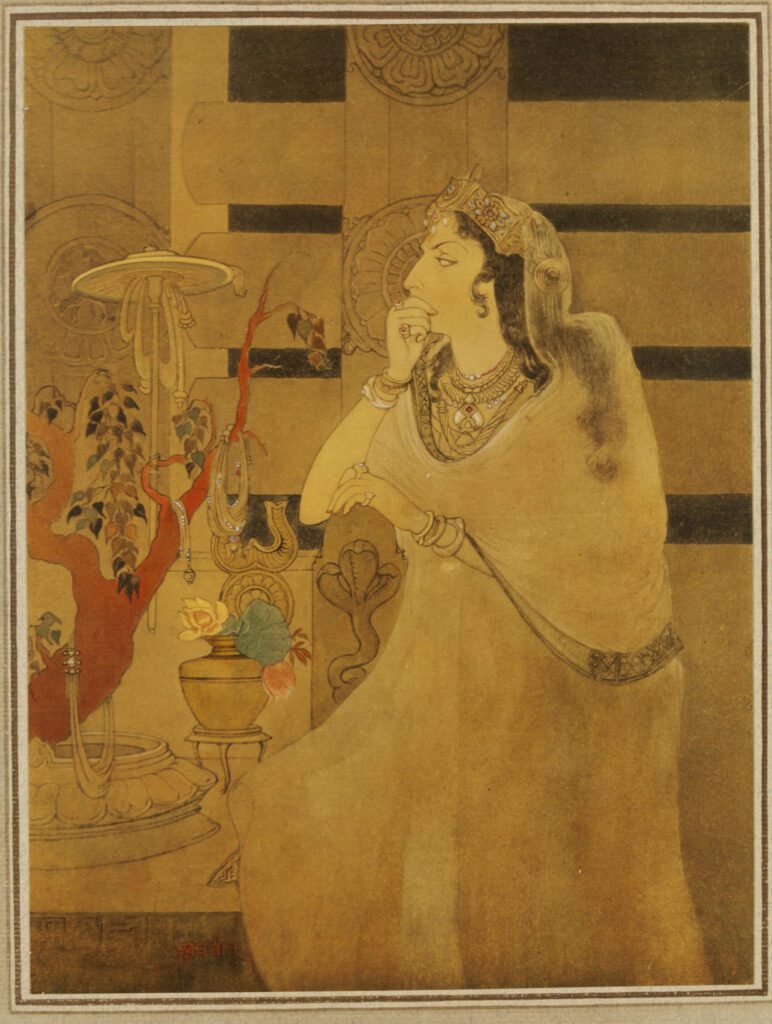
Short Biography of the Artist:
Abanindranath Tagore (1871-1951) was a pivotal figure in Indian art, often regarded as the founder of the Bengal School of Art. Tagore sought to counter the dominant Western traditions of the time by infusing Indian elements into his work, drawing inspiration from Mughal and Rajput styles, as well as from Japanese brush techniques. His approach helped revive Indian artistic traditions and shaped the emergence of modern Indian art that was deeply rooted in its own cultural identity.
Description of the Painting:
“Queen Tissarakshita” is one of Abanindranath Tagore’s remarkable works, known for its ethereal quality and subdued elegance. The painting depicts Queen Tissarakshita, who is portrayed with an aura of serene dignity and grace. Her attire is rich and traditional, adorned with intricate jewelry that reflects the opulence typical of royal depictions. The background is minimalistic, focusing the viewer’s attention on her composed expression and the fine details of her garments. Tagore’s use of muted colors and fluid lines lends a dreamlike quality to the portrait, making it a sublime representation of royal beauty.
Historical and Cultural Significance of the Depicted Queen:
Queen Tissarakshita was not just a queen by title, but a symbol of the intricate political and cultural tapestries of her time. Historical records, while sparse, suggest that she was a figure of considerable influence, navigating the complexities of royal duties and courtly expectations with a poised demeanor. In Tagore’s portrayal, Tissarakshita is more than a historical figure; she is an emblem of the grace and resilience that were expected of queens in her era. This painting, therefore, serves not only as a visual feast but as a cultural narrative that offers insight into the roles and representations of women in royal Indian history.
Through Tagore’s artistic vision, “Queen Tissarakshita” transcends its historical confines, inviting viewers to appreciate the depth of character and cultural richness that these royal figures embodied. The painting is a testament to Tagore’s skill in capturing the essence of Indian heritage and contributing to a new narrative in Indian art that celebrated its indigenous roots in a modern aesthetic framework.
2. “Maharani Jindan Kaur” by George Richmond
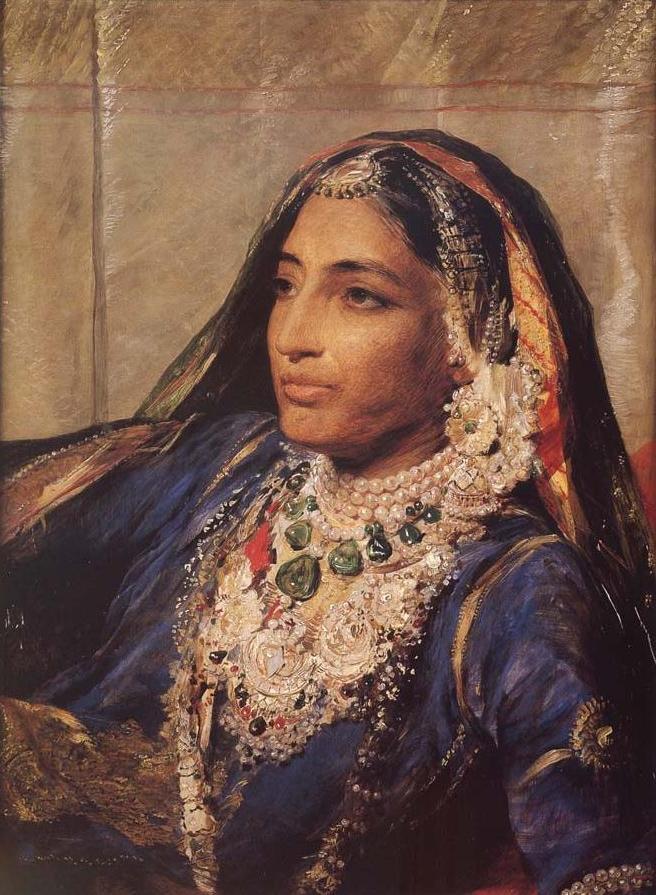
(by George Richmond)
Short Biography of the Artist:
George Richmond (1809–1896) was an English portrait painter and a member of the second generation of Britain’s Pre-Raphaelite Brotherhood. Renowned for his finely detailed and expressive portraits of prominent Victorian figures, Richmond’s work is characterized by its depth of feeling and psychological insight, traits that distinguish his artistic style. His ability to capture the essence and inner life of his subjects made him one of the most sought-after portraitists of his time.
Description of the Painting:
“Maharani Jindan Kaur” is an evocative portrait that captures the resilience and regal bearing of the queen mother of the Sikh Empire. Painted by George Richmond during a period when Jindan Kaur was living in exile in England, the painting reflects a poignant mixture of strength and melancholy. Richmond portrays her in traditional attire, richly adorned with jewelry, her gaze introspective yet commanding. The color palette is subdued, with soft, harmonious tones that emphasize her dignified presence and the regal posture she maintains despite her challenging circumstances.
Historical and Cultural Significance of the Depicted Queen:
Maharani Jindan Kaur (1817–1863) was the youngest wife of Maharaja Ranjit Singh and the mother of the last Sikh emperor, Duleep Singh. After the death of her husband and son’s accession to the throne at a young age, Jindan Kaur became the regent and was a pivotal figure in the tumultuous politics of the Sikh Empire during its decline. Her fierce resistance against British annexation and her subsequent imprisonment and exile in England mark her as a symbol of resistance and struggle against colonial domination.
The portrait by George Richmond is significant not only for its artistic merit but also for its historical context, serving as a poignant reminder of the personal and political trials Jindan Kaur endured. Richmond’s painting helps document the exile phase of a queen who played a crucial role in the resistance against British forces in India, providing a face to the stories of defiance and resilience that characterized her life. It stands as a testament to the intersections of British and Indian history and the personal stories caught in between. Through Richmond’s sensitive portrayal, Maharani Jindan Kaur is remembered not just as a queen, but as a dynamic figure of historical consequence whose life story continues to inspire and resonate in the annals of South Asian history.
3. “Maharani Chimnabai” by Raja Ravi Varma
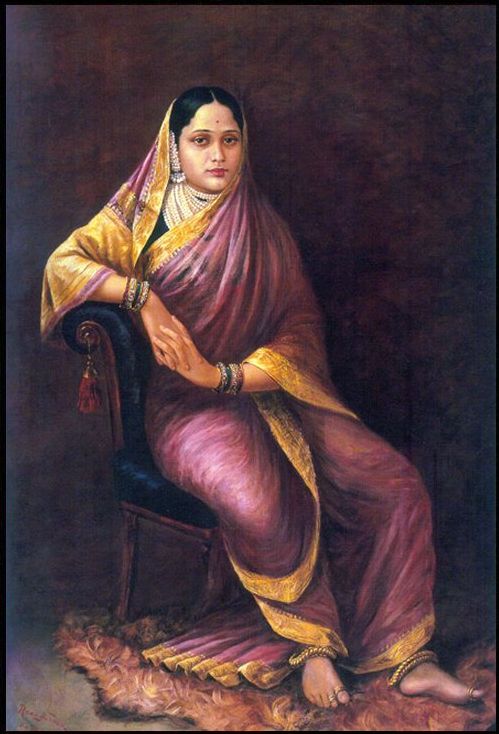
Short Biography of the Artist:
Raja Ravi Varma (1848–1906) was a celebrated Indian painter and artist, often regarded as one of the greatest painters in the history of Indian art. He is known for pioneering a fusion of Indian traditions with European academic art techniques, particularly in the realm of oil painting and realistic depictions of Indian subjects. Ravi Varma’s works capture the beauty of Indian culture and mythology, bringing to life the stories and figures of the epics as well as the nobility, with an elegance and vitality that bridged cultural and artistic gaps between the East and the West.
Description of the Painting:
“Maharani Chimnabai” is one of Raja Ravi Varma’s notable royal portraits, featuring the Maharani of Baroda, a prominent figure known for her beauty and modernizing influence. In this painting, Maharani Chimnabai is depicted in regal attire, adorned with exquisite jewelry typical of Marathi royalty. Her saree is intricately detailed, reflecting the luxurious textiles famous in Baroda. Ravi Varma’s signature realism is evident in the lifelike portrayal of her expression—serene yet powerful, perfectly capturing her known poise and dignified presence. The backdrop, subtle and understated, ensures that the focus remains on her, highlighting her stature and the refined elegance that she was known for.
Historical and Cultural Significance of the Depicted Queen:
Maharani Chimnabai, also known as Chimnabai II, was the wife of Maharaja Sayajirao Gaekwad III of Baroda. Coming into the royal family from Tanjore, she was instrumental in the modernization and reform of the education system, particularly for women, in the princely state. As a progressive queen, she advocated for women’s education and played a crucial role in the abolition of purdah (veil) within the state, promoting social reforms that were ahead of her time.
Ravi Varma’s painting of Maharani Chimnabai goes beyond mere portraiture to become a cultural icon, encapsulating the progressive spirit of an era that saw significant transformations in Indian society. The painting not only celebrates her individuality and contributions to Indian society but also serves as a visual record of the changing dynamics within the Indian royal households of the time. It illustrates the blend of tradition and modernity that characterized Chimnabai’s life and work, offering insight into the nuanced roles that royal women played in shaping the social and cultural landscapes of their time. Through this portrayal, Raja Ravi Varma commemorates her legacy, portraying her not just as a queen, but as a pioneer of reform and a beacon of change in colonial India.
4. “Queen Ahilyabai Holkar” by an Unknown Artist
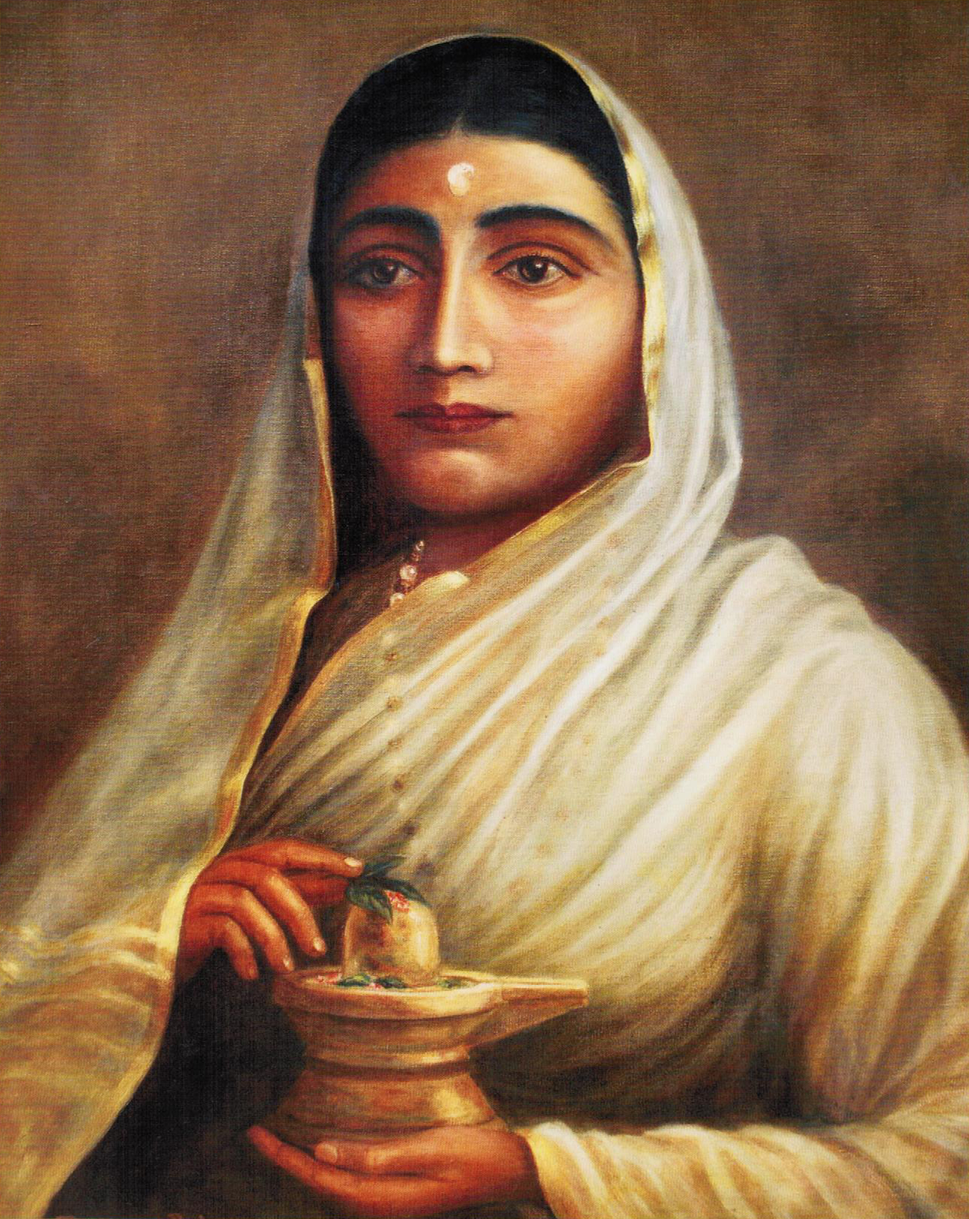
Introduction to the Artist:
The painting of “Queen Ahilyabai Holkar” is attributed to an unknown artist, a common occurrence in the historical records of Indian art where many artworks, especially those from earlier centuries, remain uncredited. This anonymity often highlights the cultural emphasis of the period which focused more on the patronage and the subjects of the artworks rather than the individual artists themselves. Despite the lack of information about the creator, the painting is a significant piece of art, showcasing the traditional style and intricate craftsmanship typical of the era.
Description of the Painting:
In this evocative portrait, Queen Ahilyabai Holkar is depicted in a poised and authoritative posture, dressed in traditional Maratha regalia. The artwork captures her in regal attire, complete with ornate jewelry and a finely woven saree, symbolizing her royal status and the rich cultural heritage of the Maratha empire. Her expression is serene yet determined, reflecting her renowned wisdom and the strong leadership qualities she was celebrated for. The background is minimalistic, focusing entirely on her figure, which is rendered with a keen attention to detail and a palette that resonates with the earthy tones typical of the region’s artistic style.
Historical and Cultural Significance of the Depicted Queen:
Queen Ahilyabai Holkar (1725-1795) was one of the most esteemed monarchs of the Maratha Empire, known for her wise and just reign. Widowed at a young age, she took over the administration of her kingdom as regent and was later crowned as the ruler. Ahilyabai was renowned for her administrative acumen, especially in infrastructure development and temple building, which earned her a place as a patron of the arts and culture. She is remembered as a pioneering figure in Indian history, who broke gender barriers to lead her people with compassion and effectiveness.
This painting of Queen Ahilyabai Holkar is not just a portrait; it is a tribute to her legacy, capturing the essence of a ruler who was far ahead of her time. The depiction serves as an inspiring reminder of her role in shaping the history of the Maratha empire and her impact on the social reforms of the period. It immortalizes her as a symbol of strength and resilience, resonating with the values she stood for, and preserving her memory in the collective consciousness of India. The anonymity of the artist adds a layer of intrigue and universality to the painting, making it a timeless piece that honors the enduring spirit of Queen Ahilyabai Holkar.
5. “Maharani Tarabai of Kolhapur” by an Unknown Artist
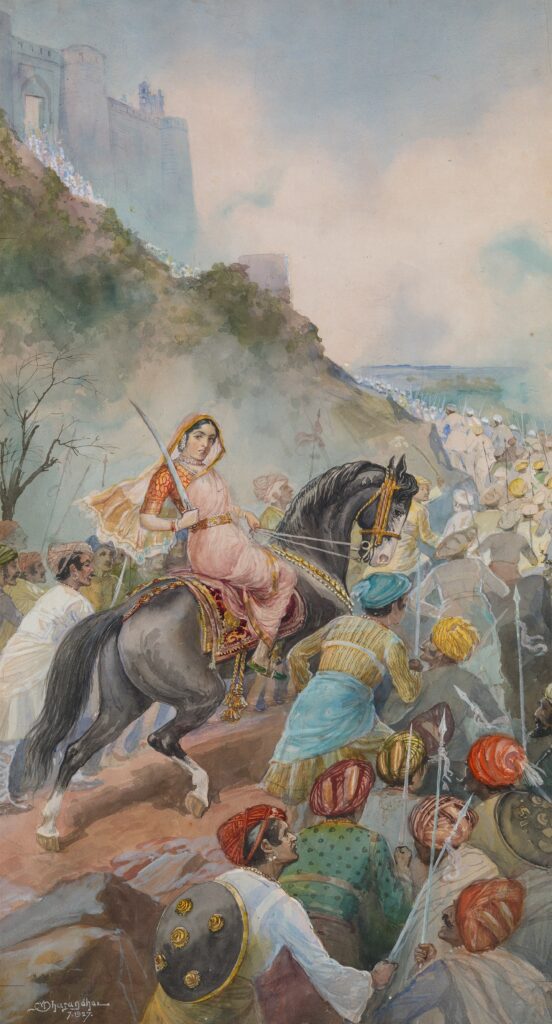
Introduction to the Artist:
Madhav Vishwanath Dhurandhar (1867-1944) was a prominent Indian painter and postcard artist who played a vital role in the development of modern art in India. Born in Kolhapur, Maharashtra, Dhurandhar displayed a natural talent for art from a young age. He went on to study at the Sir J.J. School of Art in Mumbai, where he later became the headmaster and served from 1918 to 1935.
Dhurandhar’s work was varied and extensive, encompassing a wide range of subjects including scenes of everyday life, historical events, and portraits. He was particularly adept at capturing the nuances of Indian culture and was known for his vibrant use of color and expressive storytelling through his paintings. His illustrations of women, social scenes of Mumbai, and mythological narratives are notable for their detail and liveliness.
As an influential figure in the art community, Dhurandhar was also involved in the formation of the Bombay Art Society. His contributions to Indian art were recognized with numerous awards throughout his career, including the prestigious Kalidas Samman. Dhurandhar’s legacy is preserved in his numerous paintings, illustrations, and postcards, which continue to be celebrated for their cultural significance and artistic beauty.
Description of the Painting:
The painting depicts Royal Indian Queen Maharani Tarabai engaged in the heat of battle. The artist, Madhav Vishwanath Dhurandhar, conveys the intensity of conflict through a dynamic composition that places Tarabai at the forefront, suggesting her active leadership and valiant participation in warfare. Tarabai is mounted on a black steed, captured in mid-stride, which adds a sense of movement to the scene. Her attire is both practical for battle and regal, reflecting her dual role as a warrior and a queen. The rich colors of her clothing, primarily in shades of orange and pink, contrast with the more subdued tones of the soldiers and the landscape, drawing the viewer’s focus directly to her.
The background is a blend of smoky blues and grays, perhaps indicative of the turmoil of battle, with a fortress perched atop a hill, symbolizing the stakes of the conflict. The faces of the soldiers surrounding Tarabai are rendered with individual attention, each expressing a range of emotions from determination to concern, highlighting the human element within the larger narrative of war.
The artist’s use of light and shadow, particularly the way it plays on Tarabai’s face and the folds of her clothing, imparts a sense of depth and realism to the work. Dhurandhar’s brushwork is fluid yet precise, capturing the intricate details of the armor and weaponry, which not only serves to authenticate the historical setting but also provides texture and richness to the painting.
Historical and Cultural Significance of the Depicted Queen:
Maharani Tarabai of Kolhapur was a prominent figure in the Maratha Empire and is celebrated for her role as a regent during her son’s minority. She was a formidable warrior and strategist, famously continuing the resistance against Mughal invasion in the late 17th century. Her reign is marked by a significant period of conflict and upheaval, during which she demonstrated exceptional leadership and military acumen.
The portrait serves not only as a visual representation of Maharani Tarabai but also as a cultural icon that encapsulates the valor and resilience of a woman who led her kingdom through tumultuous times. It highlights her important role in Maratha and Indian history, where she is remembered not just as a queen but as a symbol of resistance and governance. The painting, through its artistry and symbolism, portrays the enduring legacy of Maharani Tarabai, celebrating her contributions to the Maratha empire and her indelible impact on the historical narrative of India.
By presenting Maharani Tarabai in such a regal and commanding manner, the unknown artist ensures that her legacy is not only remembered but revered, providing inspiration and a point of cultural pride for future generations. This portrait remains a key piece in the mosaic of India’s rich historical tapestry, offering insight into the life and times of one of its most formidable queens.
6. “Rani Durgavati” by an Unknown Mughal Artist
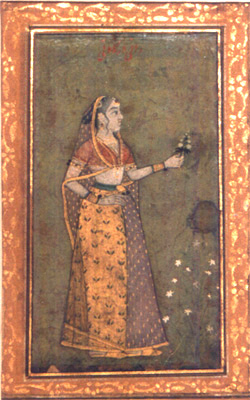
Introduction to the Artist:
The artist behind the painting of Rani Durgavati is an unknown Mughal painter, representative of the many skilled yet unnamed artists who flourished during the Mughal era in India, a period that spanned from the early 16th to the mid-18th century. These artists were often part of royal ateliers and were crucial in developing a distinctive Mughal style that combined indigenous Indian painting traditions with Persian influences, particularly in terms of refined elegance and rich detailing.
Description of the Painting:
The painting depicts Rani Durgavati, a noble and revered queen, in a traditional stance indicative of Mughal portraiture. She is adorned in regal attire, with a flowing saree embellished with gold motifs, and she wears traditional jewelry that signifies her royal status. Her posture is upright and dignified, with a sense of quiet strength emanating from her gaze and the tilt of her head as she holds what appears to be a flower. The background is understated, with a deep, earthy tone that draws the viewer’s attention to the intricacy of her garments and the delicate features of her face. The border of the painting is ornate, featuring Mughal motifs that enhance the overall grandeur of the piece.
Historical and Cultural Significance of the Depicted Queen:
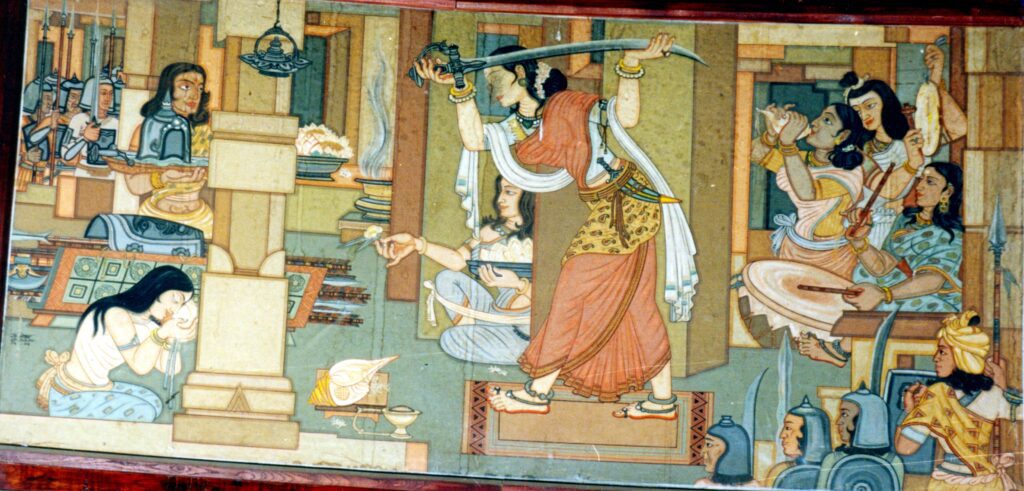
(By Beohar Rammanohar Sinha – Mural in a public auditorium., Public Domain)
Rani Durgavati (1524–1564) was the regent of the Gond kingdom in central India after the death of her husband, Dalpat Shah Mughal. She is celebrated for her bravery and strategic acumen, particularly during a time when female rulers were a rarity. Her reign was marked by a significant military campaign against the Mughal forces, where she led her troops with exceptional valor. Rani Durgavati is often remembered for her dedication to her people and her kingdom, as well as her untimely heroic death, which turned her into a symbol of resistance against the expanding Mughal empire.
In Mughal art, the portrayal of women, especially of such significant stature, was uncommon, which makes this painting not only a rare artistic endeavor but also an important cultural artifact. It reflects the esteem in which Rani Durgavati was held and serves as a lasting tribute to her legacy as a warrior queen and a protector of her realm. The unknown Mughal artist, through this painting, ensures that her valor and leadership continue to be celebrated in Indian history and art.
7. “Maharani Indira Devi” by Philip Alexius de László
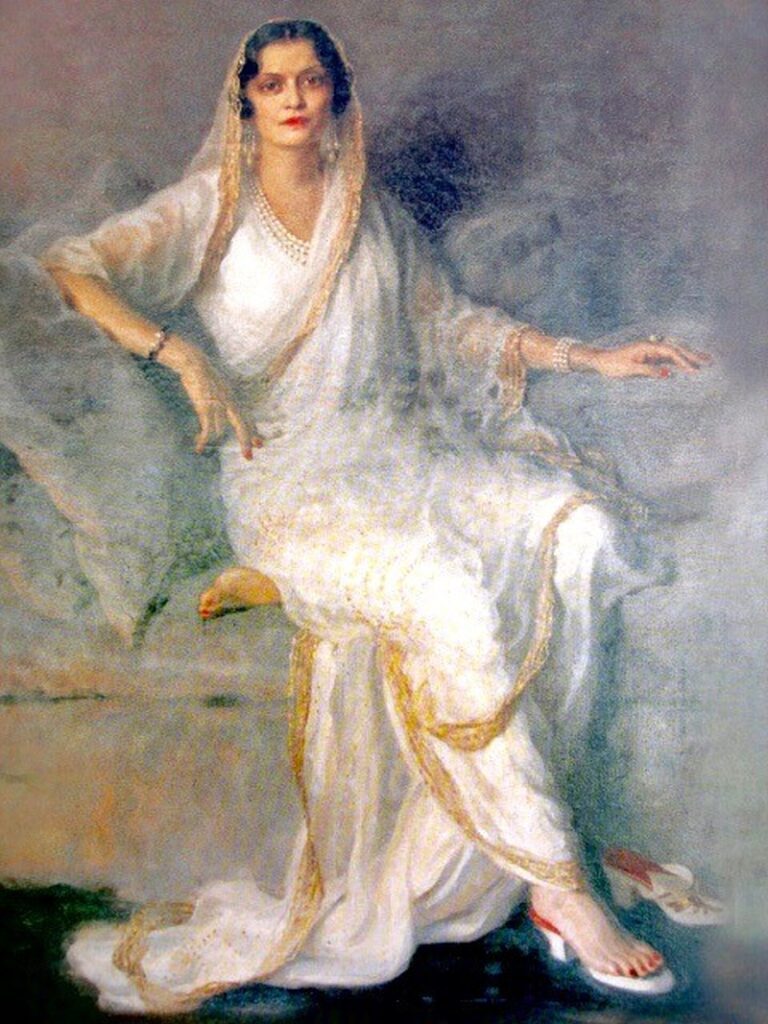
Short Biography of the Artist:
Philip Alexius de László (1869–1937) was a Hungarian-born British painter, known for his portraits of royal and aristocratic personalities. De László was celebrated for his ability to capture the character and essence of his sitters, which garnered him international acclaim and a clientele that included kings, presidents, and intellectuals. His work is characterized by a vibrant realism, combined with a masterful use of color and a profound understanding of human psychology.
Description of the Painting:
In this portrait, the Maharani is seated, exuding a serene confidence befitting her status. She is dressed in a white saree with delicate gold trimmings, a traditional attire that symbolizes purity and simplicity while the gold accents speak of opulence and rank. Her posture is relaxed yet regal, with one arm gracefully resting on a nearby surface and the other gently placed on her lap. The choice of attire, her composed demeanor, and the subtle yet assertive body language reveal the dual nature of her personality – both a modern, progressive woman and a custodian of her cultural heritage.
De László’s use of soft, diffused lighting enhances the ethereal quality of the painting, giving the subject an almost divine aura. The background is muted and indistinct, providing a contrast that further elevates the Maharani’s figure. The artist’s brushwork is evident in the fine details of her jewelry and the texture of the saree, which lend a tactile quality to the image. Her gaze is direct and engaging, suggesting intelligence and awareness, characteristics known to be true of the Maharani.
This portrait not only depicts the physical likeness of Maharani Indira Devi but also conveys her role as a significant figure in the cultural and social evolution of India during the British Raj. Her Westernized appearance combined with traditional elements reflects the cross-cultural influences of the time and her own personal style, which was noted for blending Indian and European fashions. De László’s portrait is thus an intersection of art, history, and biography, presenting Maharani Indira Devi not just as a royal figure but as a woman of substance and a symbol of her era’s evolving identity.
Historical and Cultural Significance of the Depicted Queen:
Maharani Indira Devi, born as the princess of Cooch Behar and later the queen consort of Jammu and Kashmir, was renowned not only for her beauty but also for her progressive views and her influence in the political and cultural modernization of her state. She was an avid patron of the arts and played a pivotal role in the education and empowerment of women in her region during the early 20th century.
The portrait by de László goes beyond mere representation, capturing the spirit of a time when Indian royalty was engaging actively with the challenges of modernity. Maharani Indira Devi’s portrayal by an internationally acclaimed artist also symbolizes the merging of Eastern and Western artistic and cultural streams, reflecting the global interactions of the era.
Through this painting, Philip Alexius de László not only commemorates a notable figure in Indian history but also encapsulates the broader socio-cultural dynamics of the time, offering viewers a glimpse into the life of a queen who was as much a cultural icon as she was a royal figure. This portrait remains a testament to Maharani Indira Devi’s enduring legacy as a figure of elegance, power, and progressive change in Indian royalty.
8. “Avantibai on a 2001 stamp of India” by an Unknown Artist
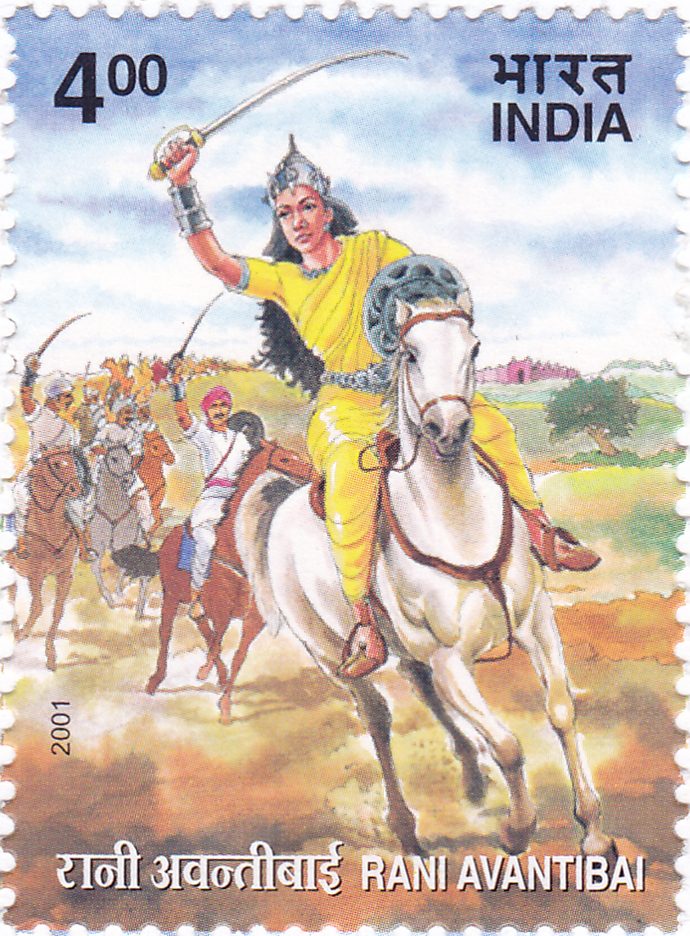
Introduction to the Artist:
The depiction of “Avantibai” on a 2001 stamp of India was created by an unknown artist, a typical scenario for many governmental and commemorative designs where the focus is on the subject rather than the creator. The artwork, intended for a postage stamp, is distinct in its approach, emphasizing clarity, symbolism, and national pride, while condensing historical narratives into a small, yet potent visual form.
Description of the Stamp:
The 2001 stamp from India is a dynamic portrayal of Rani Avantibai, a prominent figure in the 1857 Indian rebellion against British rule. It vividly captures her on horseback, leading her forces into battle. Dressed in a striking yellow saree, a color symbolizing courage and sacrifice, Avantibai is shown brandishing a sword above her head, a gesture that exemplifies her leadership and martial prowess. The action is set against a backdrop of a dusty battlefield, with her troops rallying behind her, enhancing the sense of movement and urgency.
The artist of the stamp has carefully balanced historical accuracy with artistic license, creating an image that is both evocative and respectful of Avantibai’s legacy. The attention to detail in her attire and the animation of the figures convey a narrative of heroism and the fervor of battle. This stamp not only commemorates a historical event but also serves as a tribute to the bravery of Rani Avantibai, immortalizing her spirit of resistance in India’s post-colonial history.
Historical and Cultural Significance of the Depicted Queen:
Rani Avantibai Lodhi of Ramgarh was a valiant leader who rose to prominence during India’s first war of independence in 1857. When the British threatened her kingdom, she took up arms, rallied her troops, and led them into battle herself, ultimately becoming a symbol of resistance and female empowerment in Indian history. Her dedication and sacrifice made her a legendary figure, celebrated for her courage and determination to maintain sovereignty over her region.
This portrayal on the stamp serves as a significant cultural artifact, immortalizing Rani Avantibai not just in the annals of history but also in the daily life of the nation through postal circulation. It reflects the broader efforts of post-independence India to recognize and honor the contributions of female leaders in its historical struggles. The stamp is more than a mere postage tool; it is a tribute to a heroic queen whose legacy continues to inspire generations. It reminds the citizens of the bravery and enduring spirit of those who fought for the country’s freedom and sovereignty. Through this small yet impactful medium, the unknown artist has effectively captured and disseminated the essence of Rani Avantibai’s life and legacy to a wide audience, ensuring her story remains a part of India’s collective memory.
9. “Maharani Lakshmi Bai of Travancore” by Raja Ravi Varma
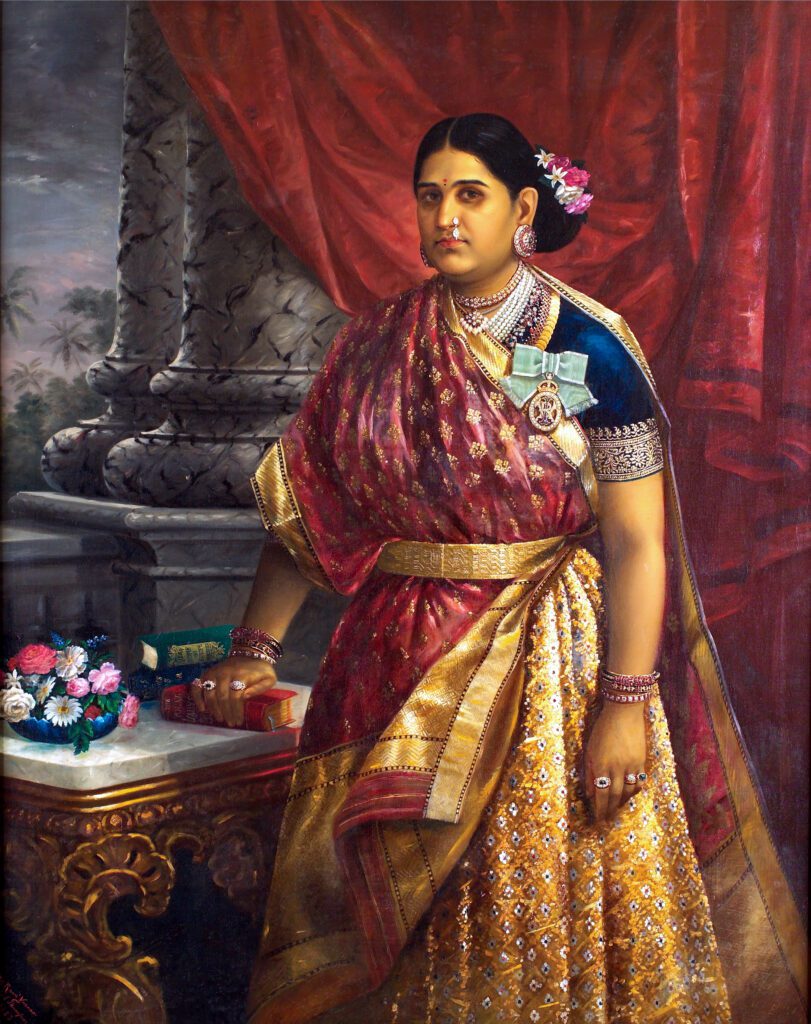
Short Biography of the Artist:
Raja Ravi Varma (1848–1906) is a name that resonates with pioneering significance in the annals of Indian art. A celebrated painter from the kingdom of Travancore in Kerala, Ravi Varma is credited with bringing Indian mythology and the Indian aesthetic to life using the techniques of European academic art. His portraits of royalty and depictions of scenes from the epics and Puranas have received acclaim both in India and internationally, making him one of the most remembered and revered figures in Indian art.
Description of the Painting:
In this regal portrait by Raja Ravi Varma, Maharani Lakshmi Bai of Travancore is depicted with an air of composed authority. Adorned in a luxuriant saree rich with gold detailing and traditional jewelry, her stature is further accentuated by the medal of honor she wears, suggesting her esteemed position. Varma’s signature realistic style is evident in the meticulous rendering of textures, from the silk of her saree to the soft petals of the flowers beside her. The Maharani’s steady gaze and the subtle tilt of her head convey a quiet confidence, emblematic of her role as a queen and her grace as a woman of her time. The backdrop, featuring a subtle depiction of the lush landscapes of Kerala, complements her stature with a serene and majestic ambiance.
Historical and Cultural Significance of the Depicted Queen:
Maharani Lakshmi Bai was a significant figure in the princely state of Travancore during the late 19th century. Known for her progressive outlook, she was instrumental in pioneering educational and social reforms in Travancore, which were ahead of their time in India. Her tenure saw the implementation of policies that promoted public instruction and the upliftment of underprivileged classes, marking a significant phase in the region’s history.
Ravi Varma’s painting of Maharani Lakshmi Bai not only immortalizes her in art but also serves as a cultural icon that encapsulates the enlightened leadership she provided. Her portrayal in this painting is not merely of a royal figure but as an emblem of progress and modernity in Indian royalty, reflecting the social and cultural ethos of her time. Through his art, Ravi Varma has celebrated her contributions and enduring legacy, which continues to inspire and resonate with the values of empowerment and reform.
This portrait, therefore, is a significant artifact, both for its artistic merit and for its historical and cultural narratives. It showcases Raja Ravi Varma’s unique ability to blend Indian traditions with European techniques, and it glorifies a queen who was much more than just a ruler—she was a visionary who strived for the betterment of her people and her land.
10. “Raja and Rani of Kurupam” by Raja Ravi Varma
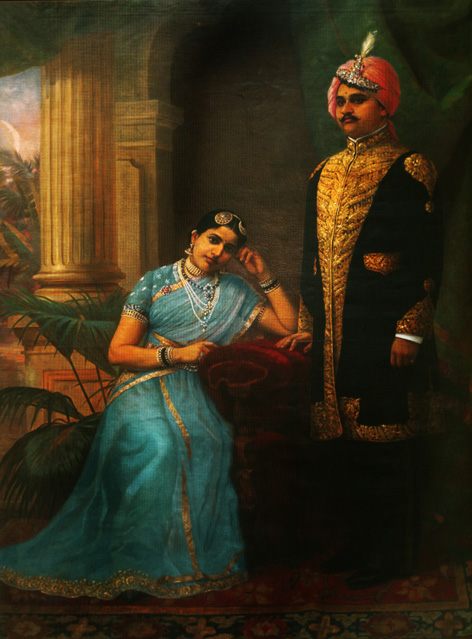
Short Biography of the Artist:
Raja Ravi Varma (1848–1906) is an iconic figure in Indian art, celebrated for his ability to bring together the European academic art techniques and the sensibilities of Indian aesthetics. His oil paintings are renowned for their classic portrayal of Indian subjects and are considered among the greatest examples of the fusion of Indian traditions with Western methods of oil painting. Varma’s profound influence on Indian art earned him the title of ‘The Father of Modern Indian Art’.
Description of the Painting:
The painting “Raja and Rani of Kurupam” by Raja Ravi Varma is a testament to the artist’s skill in portraiture, encapsulating the regal bearing and cultural richness of Indian royalty. The Raja and Rani are portrayed with poise and elegance, dressed in opulent attire reflective of their royal status and the cultural heritage of their principality. Varma’s use of color, texture, and composition brings forth the finery of their costumes and jewelry, setting them against a backdrop that signifies their noble lineage. The couple’s expressions are captured with subtlety, reflecting a blend of nobility and approachability that characterizes Varma’s portraits.
Historical and Cultural Significance of the Depicted Royals:
The Raja and Rani of Kurupam were prominent figures in the region, known for their patronage of arts and culture as well as their administrative acumen. By depicting them together, Varma not only commemorates their individual identities but also symbolizes their partnership in governance and cultural patronage. This painting, therefore, serves as a window into the royal aesthetics and cultural priorities of the time, offering insights into the societal roles expected of kings and queens in the princely states of India.
Varma’s portrayal goes beyond mere representation; it encapsulates the essence of an era when Indian royalty was engaging actively with modernity while striving to uphold traditions. The painting highlights the balance that the royals of Kurupam maintained between their cultural heritage and the influences of modern governance. Through this artwork, Varma celebrates their contributions to the cultural and political landscapes of their region, ensuring their legacies are preserved in the annals of Indian art history.
This portrait of the Raja and Rani of Kurupam is a testament to Raja Ravi Varma’s mastery in portraying complex narratives through the medium of paint, capturing not only the physical likeness but also the cultural and historical ethos of his subjects.
Artistic Legacy and Cultural Significance
The portrayal of Indian queens in art not only captures their elegance and dignity but also offers profound insights into the cultural, social, and political landscapes of their eras. These artworks serve as a bridge connecting modern viewers with historical narratives, encapsulating the rich artistic traditions and evolving roles of women in leadership throughout Indian history.
Fusion of Styles and Symbolism
Artists like Raja Ravi Varma skillfully blended European techniques with traditional Indian styles, creating lifelike portraits that celebrated both the individuality of the queens and their cultural heritage. This fusion emphasized the queens’ regal bearing and personal virtues, using symbolism and detailed iconography to highlight their political and spiritual roles within their kingdoms.
Legacy of Empowerment
The paintings of figures such as Rani Durgavati and Maharani Indira Devi resonate with themes of empowerment, showcasing these queens as pivotal figures in their societies. By immortalizing their contributions through art, these works not only preserve their legacies but also inspire ongoing discussions about the roles of women in leadership and governance. These portraits challenge historical narratives that often marginalize female contributions, promoting a richer, more inclusive understanding of history.
Educational and Inspirational Impact
Moreover, these artistic creations provide valuable educational resources that allow for a deeper understanding of the periods they depict. They serve as tools for cultural preservation, ensuring that the stories of these powerful women continue to inspire future generations. The art itself becomes a medium through which the tales of prowess, wisdom, and leadership transcend time, urging contemporary societies to recognize and value the significant roles women have played in shaping history.
Conclusion
Through the brushstrokes of both renowned and unknown artists, the legacy of India’s queens is vividly kept alive in the annals of art and history. As we engage with these artworks, they not only enhance our appreciation of India’s rich artistic heritage but also deepen our understanding of the dynamic roles played by these regal women in their respective realms. Each painting invites viewers to reflect on the past while considering the continued relevance of these historical figures in today’s discussions on gender and power.
